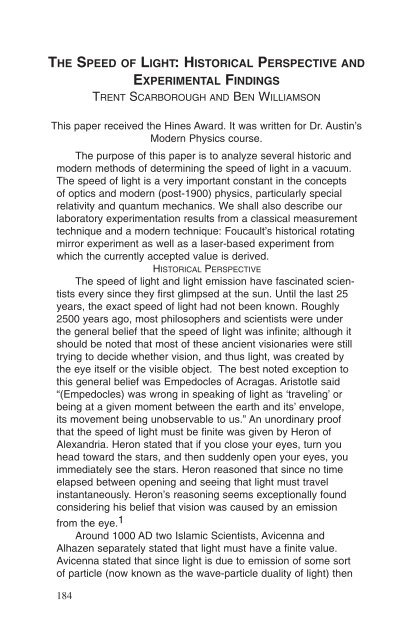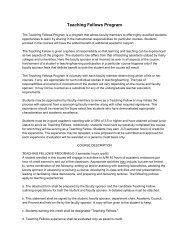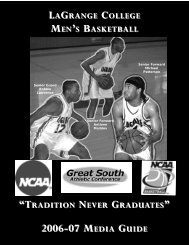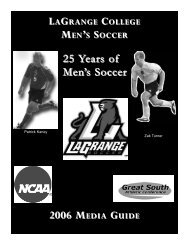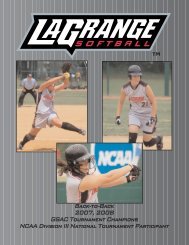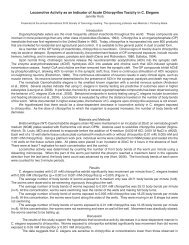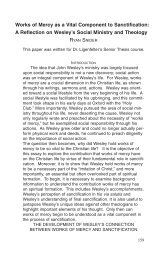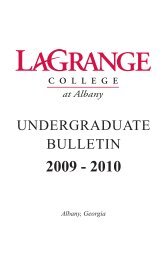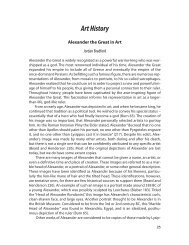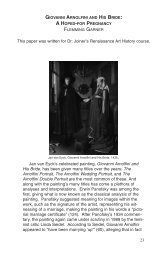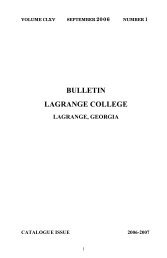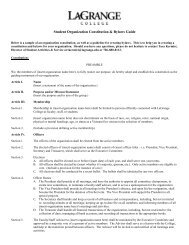The Speed of Light: Historical Perspective and Experimental Findings
The Speed of Light: Historical Perspective and Experimental Findings
The Speed of Light: Historical Perspective and Experimental Findings
Create successful ePaper yourself
Turn your PDF publications into a flip-book with our unique Google optimized e-Paper software.
THE SPEED OF LIGHT: HISTORICAL PERSPECTIVE AND<br />
EXPERIMENTAL FINDINGS<br />
TRENT SCARBOROUGH AND BEN WILLIAMSON<br />
This paper received the Hines Award. It was written for Dr. Austin’s<br />
Modern Physics course.<br />
<strong>The</strong> purpose <strong>of</strong> this paper is to analyze several historic <strong>and</strong><br />
modern methods <strong>of</strong> determining the speed <strong>of</strong> light in a vacuum.<br />
<strong>The</strong> speed <strong>of</strong> light is a very important constant in the concepts<br />
<strong>of</strong> optics <strong>and</strong> modern (post-1900) physics, particularly special<br />
relativity <strong>and</strong> quantum mechanics. We shall also describe our<br />
laboratory experimentation results from a classical measurement<br />
technique <strong>and</strong> a modern technique: Foucault’s historical rotating<br />
mirror experiment as well as a laser-based experiment from<br />
which the currently accepted value is derived.<br />
HISTORICAL PERSPECTIVE<br />
<strong>The</strong> speed <strong>of</strong> light <strong>and</strong> light emission have fascinated scientists<br />
every since they first glimpsed at the sun. Until the last 25<br />
years, the exact speed <strong>of</strong> light had not been known. Roughly<br />
2500 years ago, most philosophers <strong>and</strong> scientists were under<br />
the general belief that the speed <strong>of</strong> light was infinite; although it<br />
should be noted that most <strong>of</strong> these ancient visionaries were still<br />
trying to decide whether vision, <strong>and</strong> thus light, was created by<br />
the eye itself or the visible object. <strong>The</strong> best noted exception to<br />
this general belief was Empedocles <strong>of</strong> Acragas. Aristotle said<br />
“(Empedocles) was wrong in speaking <strong>of</strong> light as ‘traveling’ or<br />
being at a given moment between the earth <strong>and</strong> its’ envelope,<br />
its movement being unobservable to us.” An unordinary pro<strong>of</strong><br />
that the speed <strong>of</strong> light must be finite was given by Heron <strong>of</strong><br />
Alex<strong>and</strong>ria. Heron stated that if you close your eyes, turn you<br />
head toward the stars, <strong>and</strong> then suddenly open your eyes, you<br />
immediately see the stars. Heron reasoned that since no time<br />
elapsed between opening <strong>and</strong> seeing that light must travel<br />
instantaneously. Heron’s reasoning seems exceptionally found<br />
considering his belief that vision was caused by an emission<br />
from the eye. 1<br />
Around 1000 AD two Islamic Scientists, Avicenna <strong>and</strong><br />
Alhazen separately stated that light must have a finite value.<br />
Avicenna stated that since light is due to emission <strong>of</strong> some sort<br />
<strong>of</strong> particle (now known as the wave-particle duality <strong>of</strong> light) then<br />
184
TRENT SCARBOROUGH AND BEN WILLIAMSON<br />
the speed <strong>of</strong> light must be finite. Alhazen affirmed that light is<br />
movement; therefore it is at one instant in one place <strong>and</strong> at<br />
another instant in another place. Since it is impossible for light<br />
to be in both places at the same time, the transmission <strong>of</strong> light<br />
cannot be instantaneous. Sir Francis Bacon stated in 1620<br />
“Even in sight, where<strong>of</strong> the action is most rapid, it appears that<br />
there are required certain moments <strong>of</strong> time for its accomplishment…<br />
[for there are] things which by reason <strong>of</strong> the velocity <strong>of</strong><br />
motion cannot be seen – as when a ball is discharged from a<br />
musket…” <strong>The</strong>re was still uncertainty seen by Bacon’s contemporary,<br />
Johann Kepler. Kepler was famous for his work on planetary<br />
motion. Kepler reasoned that since light could be propagated<br />
into illimitable space, it required no time. Since light did<br />
not need time, it was immaterial <strong>and</strong> could <strong>of</strong>fer no resistance to<br />
a moving force. Thus according to Aristotelian mechanics (a now<br />
archaic form <strong>of</strong> mechanics that would be superseded by<br />
Newtonian mechanics at least 40 years after Kepler’s death)<br />
light must have an infinite velocity. 2<br />
<strong>The</strong> First Experiments to Determine the <strong>Speed</strong> <strong>of</strong> <strong>Light</strong><br />
A contemporary <strong>of</strong> Kepler <strong>and</strong> Bacon, was Galileo Galilee.<br />
Galileo was the first person to actually attempt to measure the<br />
speed <strong>of</strong> light. Galileo devised that two people should go st<strong>and</strong><br />
with covered lanterns a known distance apart. When one uncovered<br />
their lantern, the other would quickly uncover his lantern<br />
<strong>and</strong> the time difference would be measured. After testing this<br />
experiment at a distance less than one mile, Galileo concluded:<br />
“I have not been able to ascertain with certainty whether the<br />
appearance <strong>of</strong> the opposite light was instantaneous or not; but if<br />
not instantaneous it is extraordinarily rapid – I should call it<br />
momentary.” 2 It could be said that Galileo at least established a<br />
lower limit for the speed <strong>of</strong> light. It is known today that about a<br />
thirtieth <strong>of</strong> a second is the minimum time interval distinguishable<br />
by the unaided, human eye. <strong>The</strong>n Galileo’s experiment put a lower<br />
limit <strong>of</strong> about 9.65 x 10 4 meters per second (m/s) on the speed <strong>of</strong><br />
light; which is about 3000 times less than the currently accepted value.<br />
Renee Descartes sought to get an actual number by greatly increasing<br />
the distance. Descartes proposed that if light was finite with time<br />
than eclipses <strong>of</strong> the moon would be visible on earth later than when<br />
the sun, moon <strong>and</strong> earth were calculated to be in a straight line. When<br />
no delay was detected, Descartes proceeded to declare that light<br />
must be instantaneous. 3<br />
185
THE SPEED OF LIGHT<br />
Given the failure <strong>of</strong> Galileo <strong>and</strong> Descartes, Ole Roemer<br />
sought to determine the velocity <strong>of</strong> light by observing even further<br />
distances. Roemer studied the eclipses <strong>of</strong> Jupiter’s moon,<br />
Io. Roemer timed the moment that Io became hidden by Jupiter<br />
<strong>and</strong> then the moment that it reappeared. He would then compare<br />
this time interval as Earth moved closer <strong>and</strong> further away<br />
from Jupiter. Roemer realized that as Earth moved away from<br />
Jupiter, the time interval for time spent hidden increased. As<br />
earth rotated back closer to Jupiter, the hidden time interval<br />
would slowly decrease. Although Roemer himself never actually<br />
gave a numerical value for the speed <strong>of</strong> light, he did state that<br />
light requires about a second (s) <strong>of</strong> time to traverse a distance<br />
equal to the diameter <strong>of</strong> the earth. From this statement it can be<br />
deduced that light would require 22 minutes to traverse the<br />
earth’s orbit. 3 <strong>The</strong>se numbers were combined by Christian<br />
Huygens to give the value <strong>of</strong> 2.20 x 10 8 m/s which gives a percent<br />
error <strong>of</strong> about 26% from the currently accepted value. 1<br />
Although the value is inaccurate, it was the first reproducible<br />
result for the speed <strong>of</strong> light <strong>and</strong> gave pro<strong>of</strong> that the speed <strong>of</strong><br />
light was finite.<br />
For the next 150 years people would continue to adapt<br />
Roemer’s experiment <strong>and</strong> come up with a multitude <strong>of</strong> values<br />
for the speed <strong>of</strong> light. Even Isaac Newton attempted to determine<br />
the speed <strong>of</strong> light <strong>and</strong> predicted it to be about 2.41x 10 8<br />
m/s. Newton derived his speed using Cassini’s value for the<br />
retardation <strong>of</strong> light from the sun <strong>and</strong> his own guess that the distance<br />
from the earth to the sun was approximately 1.12 x 10 11<br />
meters (m). If Newton had used Cassini’s own value for the distance<br />
from the earth to the sun, 1.46 x 10 11 m, he would have<br />
arrived at a speed <strong>of</strong> light <strong>of</strong> approximately 3.05 x 10 8 m/s, only<br />
a 2 percent error from the now accepted value. 3<br />
Up until the 1840s, no one had been able to determine an<br />
accurate measurement for the speed <strong>of</strong> light using only terrestrial<br />
measurements. In 1849, Arm<strong>and</strong> Fizeau sought to remedy<br />
this problem. Fizeau set up a rotating cog wheel with 720 teeth<br />
spinning at 12.6 revolutions per second (rev/s). Fizeau sent a<br />
lamp beam through the teeth <strong>and</strong> then 8 kilometers (10 3 m)<br />
away to a mirror. Upon returning, the beam was brought though<br />
the gaps <strong>of</strong> the teeth. As the light passed through the gaps on<br />
186
TRENT SCARBOROUGH AND BEN WILLIAMSON<br />
their return, the light was blocked by the teeth as they moved<br />
into the position <strong>of</strong> the gaps. <strong>The</strong> time taken for the teeth to<br />
move this distance was equal to the time taken for the light to<br />
travel to the mirror <strong>and</strong> back, 16 km. Using simple math he<br />
obtained a value <strong>of</strong> 3.15 x 10 8 m/s; roughly 5% too high. 4<br />
Fizeau’s former friend/partner Leon Foucault would use the<br />
same concept in 1862 except with a spinning mirror <strong>and</strong> determine<br />
the speed <strong>of</strong> light to be 2.98 x 10 8 m/s, within 1% <strong>of</strong> the<br />
correct value. 5<br />
An important revelation came about near the end <strong>of</strong> the<br />
nineteenth century. At the time, the theory <strong>of</strong> light acting as a<br />
wave was well accepted by the scientific community, thanks to<br />
the earlier work <strong>of</strong> Thomas Young <strong>and</strong> Augustin Fresnel.<br />
However, there was a troubling problem in the conventional<br />
logic: If light is a wave, then there must exist some form <strong>of</strong><br />
medium upon which it travels, as all other known waves did<br />
have a medium <strong>of</strong> transmission. In 1873, James Clerk Maxwell<br />
used his electromagnetic theory <strong>of</strong> light to determine the speed<br />
<strong>of</strong> light in a vacuum mathematically (See appendix 1 for a derivation):<br />
where _ o <strong>and</strong> _ 0 are the permeability<br />
<strong>and</strong> permittivity <strong>of</strong> free space, respectively. 6 He proposed<br />
that such a medium, called the “luminiferous ether” must<br />
be consistent with electromagnetic theory <strong>and</strong> that a sensitive<br />
enough instrument could discern its properties. By 1880, the<br />
concept <strong>of</strong> the ether was well accepted. 7<br />
Finding this mysterious ether became the next goal <strong>of</strong><br />
physics, <strong>and</strong> in the 1880’s, a famous experiment known as the<br />
Michelson-Morley Experiment would yield startling results. Albert<br />
Michelson developed an extremely precise instrument called the<br />
interferometer, which could detect very small phase differences<br />
between two light waves. His device used an incident beam <strong>of</strong><br />
monochromatic light partially reflected <strong>and</strong> partially transmitted<br />
by a silvered glass surface. <strong>The</strong> light is then reflected by two<br />
mirrors at perpendicular angles (the theory being that one <strong>of</strong> the<br />
paths <strong>of</strong> light will be parallel to the Earth’s motion through the<br />
ether flow <strong>and</strong> one will be perpendicular, so there will be a<br />
phase difference between the two beams). Using classical<br />
mechanics he determined that there should be a time difference<br />
187
THE SPEED OF LIGHT<br />
between the two beams <strong>of</strong> 8 x 10 -17 s, which would result in<br />
0.04 fringes in the interference pattern. Though his instrument<br />
should have been able to detect a pattern half the size <strong>of</strong> the<br />
expected result, he found nothing. In 1887, Michelson teamed<br />
up with Edward Morley, who would make great improvements on<br />
Michelson’s device. <strong>The</strong> path length <strong>of</strong> the device was greatly<br />
extended, increasing the expected fringe shift tenfold. Even<br />
though the device could detect a fringe shift as small as 0.005,<br />
they observed absolutely no effect. <strong>The</strong> results were consistent<br />
over several subsequent retrials, <strong>and</strong> no substantial results were<br />
ever observed. <strong>The</strong> ether did not seem to exist. Today, over a<br />
century later, there is still no realistic evidence for the ether theory.<br />
7 Albert Michelson would then improve on Foucault’s apparatus<br />
by using better optical lenses <strong>and</strong> a longer baseline for the<br />
distance. Beginning in 1906, Michelson measured the speed <strong>of</strong><br />
light to be 2.99853 x 10 8 m/s. Over the next 25 years,<br />
Michelson would continue to revise his own experiment in<br />
search <strong>of</strong> a definitive measurement. In his final experiment,<br />
Michelson combined the most up to date electronics <strong>and</strong> optics<br />
available with a vacuum tube for his light beam. Unfortunately<br />
he did not live to see his collaborators, Pease <strong>and</strong> Pearson,<br />
publish the results <strong>of</strong> 2.99774 x 10 8 m/s; this result is within<br />
.006% <strong>of</strong> today’s accepted value. 8<br />
Using Maxwell’s theory R. Blondlot was the first to measure<br />
the product <strong>of</strong> the frequency <strong>and</strong> wavelength <strong>of</strong> an electromagnetic<br />
wave. Blondlot adapted Foucault’s apparatus to measure<br />
the speed <strong>of</strong> electricity in a conductor <strong>and</strong> found it to be very<br />
close the value found by Maxwell’s theory <strong>of</strong> 2.99792251 x 10 8<br />
m/s. 9<br />
<strong>The</strong> 1907 experiment <strong>of</strong> E. B. Rosa <strong>and</strong> N. E. Dorsey consists<br />
<strong>of</strong> measuring the speed <strong>of</strong> light by comparing the experimentally<br />
determined capacitance <strong>of</strong> a capacitor in electromagnetic<br />
units <strong>and</strong> electrostatic units with predetermined currents<br />
from a current balance. This method produces a value <strong>of</strong><br />
2.99788 x 10 8 m/s, which is 0.000015 % below the accepted<br />
value. 10<br />
In 1958 K. D. Froome used klystron oscillators to measure<br />
the speed <strong>of</strong> light by analyzing both the frequency <strong>and</strong> the<br />
188
TRENT SCARBOROUGH AND BEN WILLIAMSON<br />
wavelength <strong>of</strong> millimeter waves. <strong>The</strong>re was an uncertainty<br />
resulting from the limited wavelength <strong>of</strong> possible radiation,<br />
because the longer wavelengths used in this experiment could<br />
not be measured as accurately as shorter ones. <strong>The</strong> result<br />
achieved from Froome’s work was a value <strong>of</strong> 2.997925 x 10 8<br />
m/s. This result was the best <strong>of</strong> its time as laser technology was<br />
not capable <strong>of</strong> more accurate measurements. 9<br />
Modern Measurements <strong>of</strong> the <strong>Speed</strong> <strong>of</strong> <strong>Light</strong><br />
From 1972 to 1984, many measurements would be made<br />
using the improved technology <strong>of</strong> tungsten-nickel point contact<br />
diodes. <strong>The</strong> new diodes resulted in various speed <strong>of</strong> light measurements<br />
in laser-based experiments, such as Evanson’s 1973<br />
experiment resulting in a speed <strong>of</strong> light value <strong>of</strong> 2.997924574 x<br />
10 8 m/s. This highly accurate result is one <strong>of</strong> the many scientific<br />
benefits <strong>of</strong> stabilized lasers. Before this innovation, emission<br />
radiation from atoms was the only spectrally pure light available<br />
for testing, <strong>and</strong> the frequency <strong>of</strong> such light is difficult to control.<br />
A way <strong>of</strong> locking the frequency <strong>of</strong> the emission was necessary<br />
to accurately measure the speed <strong>of</strong> light by this method, which<br />
was found in the sub-Doppler saturated absorption spectroscopy.<br />
This technique permits the locking <strong>of</strong> frequency <strong>of</strong> the<br />
radiation into a very small window <strong>of</strong> spectral features, so that<br />
both quantities wavelength <strong>and</strong> frequency remain fixed. Since<br />
the development <strong>of</strong> sub-Doppler saturated absorption spectroscopy,<br />
several sources have been stabilized. <strong>The</strong> heliumneon<br />
with a wavelength <strong>of</strong> 3.39 µm (10 -6 m) stabilized with saturated<br />
absorption in methane. Carbon dioxide with a 10 µm<br />
wavelength stabilized to florescence with saturated carbon dioxide.<br />
A red helium-neon source stabilized to iodine-saturated<br />
absorption. <strong>The</strong>se are the three main laser sources used to<br />
measure the speed <strong>of</strong> light, <strong>and</strong> sometimes they are combined.<br />
In the case <strong>of</strong> Fabry-Perot interferometers, two wavelengths<br />
are compared by the observation <strong>of</strong> interference fringes<br />
<strong>of</strong> waves refracting between two mirrors. This has been used to<br />
measure the speed <strong>of</strong> light many times <strong>and</strong> normally using the<br />
st<strong>and</strong>ard-length 605.8 nm (10 -9 m) orange lasers using a krypton<br />
source. Unfortunately, this method results in an error <strong>of</strong><br />
around four parts per hundred million. More accurate measurements<br />
could be made by better measurements <strong>of</strong> emission frequency.<br />
Better results were achieved with techniques using<br />
189
THE SPEED OF LIGHT<br />
high-speed nonlinear devices to generate harmonics. Since<br />
these measurements were based on frequency, they were ten<br />
times more accurate than wavelength-based measurements. 9<br />
<strong>The</strong>se measurements showed that the uncertainty largely<br />
stemmed from the asymmetry <strong>of</strong> the krypton line, upon which<br />
the current st<strong>and</strong>ard meter was based. It became apparent that<br />
the accuracy <strong>of</strong> the st<strong>and</strong>ard meter could be greatly improved by<br />
redefinition. <strong>The</strong> direct measuring the frequency <strong>of</strong> the 633 nm<br />
iodine stabilized helium-neon laser <strong>and</strong> the 576 nm spectroscopic<br />
line <strong>of</strong> iodine, along with many other such direct measurements,<br />
was the final step to redefining the meter. In 1983, the<br />
General Conference on Weights <strong>and</strong> Measures redefined the<br />
meter as the distance traveled by light in a vacuum over a period<br />
<strong>of</strong> 1/299 792 458 <strong>of</strong> a second. Consequentially, the speed <strong>of</strong><br />
light in a vacuum is defined as a constant, not to be changed or<br />
re-measured. This definition <strong>of</strong> the meter has remained strong<br />
because a definition based on a st<strong>and</strong>ard such as the krypton<br />
lamp can be continuously made more accurate without the need<br />
to form a new definition for the parameters. 11<br />
Modern Reproduction <strong>of</strong> Foucault’s <strong>Speed</strong> <strong>of</strong> <strong>Light</strong> Experiment<br />
Our first experiment in the LaGrange College Physics<br />
Laboratory was closely based on the 1862 experiment by<br />
Foucault. <strong>The</strong> equipment used consisted <strong>of</strong> the PASCO<br />
Complete <strong>Speed</strong> <strong>of</strong> <strong>Light</strong> Apparatus (OS-2961A). <strong>The</strong> experiment<br />
relates the angular velocity <strong>of</strong> a rotating mirror to a spectral<br />
displacement to determine the speed <strong>of</strong> light in a vacuum. 13<br />
In our experiment; a class 2 laser (PASCO 1508-1) with a 633<br />
nm helium-neon gas source <strong>and</strong> 0.8 miliwatt (10 -3 W) power<br />
output was used to generate our incident emission. Foucault’s<br />
original experiment used a st<strong>and</strong>ard inc<strong>and</strong>escent light source.<br />
<strong>The</strong> beam was focused through a 48 mm (10 -3 m) focal length<br />
lens placed 6.95 cm (10 -2 m) from the incident light source<br />
(which hereafter the incident source will be our reference origin<br />
for all values except the fixed mirror distance from the rotating<br />
mirror) <strong>and</strong> past a beam splitter placed at 18.22 cm. <strong>The</strong> laser<br />
beam was focused through a 252 mm focal length lens at 38.27<br />
cm <strong>and</strong> then directed into a rotating mirror at 83 cm, from which<br />
the beam was directed at an angle <strong>of</strong> 25º to a fixed mirror<br />
11.407 m away. <strong>The</strong> laser beam was reflected back into the<br />
rotating mirror, which was then reflected back into the beam<br />
190
TRENT SCARBOROUGH AND BEN WILLIAMSON<br />
splitter. From the microscope on the beam splitter, the spectral<br />
field could be observed, <strong>and</strong> thus the image point (See<br />
Appendix 3 for diagrams).<br />
After meticulously aligning the equipment, we were ready to<br />
begin. <strong>The</strong> emission filtering <strong>of</strong> the beam splitter produced the<br />
unique pattern <strong>of</strong> a small, sharp, bright dot (our image point)<br />
adjacent to a bright <strong>and</strong> equally sharp b<strong>and</strong>, quite separate from<br />
the rest <strong>of</strong> the apparent emission in the spectral field. <strong>The</strong> rotating<br />
mirror was activated <strong>and</strong> the speed was increased to<br />
approximately 600 rotations per second (rev/s) to allow the<br />
motor to warm up. After three minutes, the speed was increased<br />
to 1 000 rev/s <strong>and</strong> then the speed to its maximum velocity,<br />
approximately 1 500 rev/s.<br />
As the mirror rotated continuously at high velocity, a laser<br />
pulse was generated which resulted in a strange phenomenon:<br />
the incident light strikes the rotating mirror at a different angle<br />
than the reflected light thus, allowing measurable displacement<br />
with the image point to be seen. <strong>The</strong> small dot in the spectral<br />
field was displaced <strong>and</strong> measured with a micrometer. This<br />
process was repeated at least twice for each direction (clockwise<br />
<strong>and</strong> counterclockwise), <strong>and</strong> the results were tabulated.<br />
Using these results, we were able to determine a value for the<br />
speed <strong>of</strong> light <strong>of</strong> 2.992 x 10 8 m/s for the speed <strong>of</strong> light in air. 12<br />
<strong>The</strong> value found is 0.198% below the currently accepted value.<br />
Foucault’s original experiment produced a value <strong>of</strong> the speed <strong>of</strong><br />
light, c = 2.99792 x 10 8 m/s, approximately 1% lower than the<br />
modern value. It should be noted that in this experiment the<br />
speed <strong>of</strong> light is measured in air, the value <strong>of</strong> which mathematically<br />
should be approximately 0.03% lower. <strong>The</strong> greater precision<br />
in our results stems from several factors, almost all <strong>of</strong> them<br />
due to our equipment. We were able to use a laser light source,<br />
where Foucault had to use st<strong>and</strong>ard light bulb. We were also<br />
able to electronically control <strong>and</strong> measure precisely our rotation<br />
speed, whereas, Foucault did not have the use <strong>of</strong> any modern<br />
electronics.<br />
191
THE SPEED OF LIGHT<br />
FIGURE 1: DIAGRAM FOR THE FOUCAULT SPEED OF LIGHT SETUP<br />
LASER EXPERIMENT TO DETERMINE THE SPEED OF LIGHT<br />
Another more modern experiment that we performed was<br />
the determination <strong>of</strong> the speed <strong>of</strong> light using a PASCO Scientific<br />
Laser <strong>Speed</strong> <strong>of</strong> <strong>Light</strong> Apparatus (AP-8586). This approach<br />
measures the phase shift <strong>of</strong> light, compared to a reference<br />
point, as it travels different distances. This is the approach that<br />
is most commonly used today in order to determine the speed <strong>of</strong><br />
light, or to determine the accepted value <strong>of</strong> the fundamental<br />
length in the metric system, the meter. <strong>The</strong> equipment used in<br />
this experimented consisted <strong>of</strong>: a function generator (SB-<br />
9549A), Diode Laser with power adapter (OS-8528A), component<br />
carrier (OS-9107), +127 mm lens (OS-9134), Laser<br />
Alignment Bench (OS-9172), <strong>Light</strong> receiver, 4 Stainless Steel<br />
pads, Concave Mirror Display (003-02226), a 60 MHz (10 6 Hz)<br />
oscilloscope, a tripod, a tape measure, a plumb bob <strong>and</strong> a diode<br />
laser. Most <strong>of</strong> the equipment is fairly self explanatory, but the<br />
diode laser emits an intense, narrowly-focused beam <strong>of</strong> light. In<br />
this experiment the function generator modulates the light at an<br />
intensity <strong>of</strong> approximately 3 MHz. <strong>The</strong> concave mirror helps to<br />
focus the light as it is reflected. <strong>The</strong> light receiver is designed for<br />
receiving audio <strong>and</strong> video signals transmitted via modulated<br />
light. <strong>The</strong> +127 mm lens is used to focus the light onto the element<br />
<strong>of</strong> the receiver. <strong>The</strong> experiment was conducted along the<br />
first floor hallway <strong>of</strong> the Callaway Science Building in order to<br />
increase path distance.<br />
<strong>The</strong> laser is mounted on an L-shaped bracket with the<br />
bracket bent away from the laser. <strong>The</strong> receiver is placed at the<br />
back <strong>of</strong> the laser alignment bench, while the laser itself is<br />
mounted the very front <strong>of</strong> the bench. <strong>The</strong> bench was then<br />
192
TRENT SCARBOROUGH AND BEN WILLIAMSON<br />
moved to the edge <strong>of</strong> the table so that an exact measurement<br />
could be taken for the distance from the mirror to the laser.<br />
Once the laser was turned on, the lens was moved in order to<br />
focus the reflected laser beam into the most precise dot onto the<br />
receiver. Different lengths are measured out on the floor ranging<br />
from approximately 1 m to 23 m. Once all <strong>of</strong> the equipment was<br />
set up, data collection could begin. <strong>The</strong> function generator is set<br />
to a square wave with a DC <strong>of</strong>fset <strong>and</strong> the frequency is set to<br />
2.683 x 10 6 Hertz (Hz). On the oscilloscope, channel 1 is set to<br />
1 volt per division (V/div), direct current, channel 2 is set to 1<br />
V/div, alternating current, <strong>and</strong> the trigger level was set to<br />
approximately 2.5 volts (V) <strong>and</strong> the base time set to 0.2<br />
microseconds per division (µs/div). <strong>The</strong> DC <strong>of</strong>fset <strong>and</strong> amplitude<br />
on the function generator is then tuned to maximize the sine<br />
wave signal on channel 2.<br />
Using a Vernier caliper, an initial distance between the<br />
square wave <strong>of</strong> channel 1 <strong>and</strong> the sine wave <strong>of</strong> channel 2 is<br />
found to be 0.25 cm. This initial distance reading took place with<br />
the mirror at a distance from the laser <strong>of</strong> 1.080 m. This initial<br />
reading would then become the baseline for all the following<br />
measurements to be based upon. <strong>The</strong> mirror is then moved<br />
back approximately 2 m <strong>and</strong> the distance between the square<br />
wave <strong>of</strong> channel 1 <strong>and</strong> the sine wave <strong>of</strong> channel 2 is re-measured.<br />
This procedure is repeated until the distance from the mirror<br />
<strong>and</strong> the laser reaches 23 m. <strong>The</strong> change in distance <strong>of</strong> the<br />
square wave to sine wave minus the initial distance <strong>of</strong> 0.25 cm<br />
(?t) is plotted against 2 times the laser to mirror distance minus<br />
the initial distance <strong>of</strong> 1.080 m (?d). In order to get our ?t measurements<br />
out <strong>of</strong> centimeters <strong>and</strong> into seconds we have to apply<br />
what we know about the set up <strong>of</strong> the equipment. Since we<br />
have the division setting on 0.2 µs/div, we measured that 1.00<br />
cm equals 5 divisions (div) on the oscilloscope. <strong>The</strong>refore 1 div<br />
is equal to 0.20 cm, <strong>and</strong> every cm is equal to 1 µs or 1000<br />
nanoseconds (ns). Using Micros<strong>of</strong>t Excel, a spreadsheet <strong>and</strong> a<br />
graph were created. By connecting the data points, a line is<br />
formed <strong>and</strong> the slope <strong>of</strong> the line found. Since ?t vs. ?v gives the<br />
slope <strong>of</strong> the line in units <strong>of</strong> m/s. We can deduce that the slope,<br />
2.956 x10 8 m/s, is the speed <strong>of</strong> light. Our measurement is only<br />
1.4% <strong>of</strong>f from the currently accepted value <strong>of</strong> 2.99792 x 10 8<br />
m/s.<br />
193
THE SPEED OF LIGHT<br />
FIGURE 2: DIAGRAM OF LASER SPEED OF LIGHT SETUP<br />
TABLE OF RESULTS<br />
194
TRENT SCARBOROUGH AND BEN WILLIAMSON<br />
FIGURE 3: GRAPHICAL REPRESENTATION OF RESULTS<br />
In the above graph, the light grey line represents the<br />
known value for the speed <strong>of</strong> light, .2997 meters per nanosecond<br />
(m/ns) equivalently 2.997 x 10 8 m/s. <strong>The</strong> dark grey line represents<br />
the slope <strong>of</strong> our values obtained, .2956 m/ns or 2.956 x<br />
10 8 m/s. <strong>The</strong> black t-shaped lines coming from the dark grey<br />
line represent a plus or minus 5% value. Our obtained value is<br />
only 1.36% <strong>of</strong>f from the current measurement.<br />
SUMMARY<br />
Every major scientist from Aristotle to Galileo to Newton to<br />
Michelson has pondered on the speed <strong>of</strong> light. During our history<br />
research, we discovered that there have been major attempts<br />
by a vast number <strong>of</strong> scientists in order to determine the speed <strong>of</strong><br />
light. <strong>The</strong> value <strong>of</strong> the speed <strong>of</strong> light is crucial to Einstein’s theory<br />
<strong>of</strong> special relativity. <strong>The</strong> theory states that space <strong>and</strong> time are<br />
not a constant but; the speed <strong>of</strong> light never varies, regardless <strong>of</strong><br />
time or space. <strong>The</strong> phenomena <strong>of</strong> time dilation <strong>and</strong> length contraction<br />
cannot be explained without an accurate value for the<br />
speed <strong>of</strong> light. We chose to do two <strong>of</strong> these experiments <strong>and</strong><br />
compare our results with today’s accepted value. While one <strong>of</strong><br />
our experiments was a modern interpretation <strong>of</strong> an old experiment,<br />
the other experiment used modern st<strong>and</strong>ards <strong>and</strong> both<br />
were accurate in determining the speed <strong>of</strong> light to within 2% <strong>of</strong><br />
the currently accepted value <strong>of</strong> 2.99792 x 10 8 m/s.<br />
195
THE SPEED OF LIGHT<br />
WORKS CITED<br />
1 I. B. Cohen, Roemer <strong>and</strong> the First Determination <strong>of</strong> the<br />
Velocity <strong>of</strong> <strong>Light</strong>, Isis, 31, 2 (1940)<br />
2 N. D. Tyson, <strong>Speed</strong> Limit, Natural History, 114, 1 (2005)<br />
3 C. B. Boyer, Early Estimates <strong>of</strong> the Velocity <strong>of</strong> <strong>Light</strong>, Isis, 33, 1 (1941)<br />
4 Hutchinson Dictionary <strong>of</strong> Scientific Biography, Arm<strong>and</strong><br />
Hippolyte Louis Fizeau, http://www.accessscience.com<br />
5 Hutchinson Dictionary <strong>of</strong> Scientific Biography, Jean Bernard<br />
Léon Foucault, http://www.accessscience.com<br />
6 See appendix 1 for derivation<br />
7 S.T. Thornton, Modern Physics for Scientists <strong>and</strong> Engineers,<br />
3rd ed., (Thomson Brooks/Cole, Belmont, CA, 2006)<br />
8 Hutchinson Dictionary <strong>of</strong> Scientific Biography, Albert Abraham<br />
Michelson, http://www.accessscience.com<br />
9 K. M. Evenson, <strong>Light</strong>, http://www.accessscience.com<br />
10 Encyclopedia <strong>of</strong> Science <strong>and</strong> Technology Online, Rosa <strong>and</strong><br />
Dorsey Method,http://www.accessscience.com<br />
11 D. B. Sullivan, <strong>Speed</strong> <strong>of</strong> <strong>Light</strong> from Direct Frequency <strong>and</strong><br />
Wavelength Measurements,http://nvl.nist.gov/pub/nist<br />
pubs/sp958-lide/191-193.pdf<br />
12 See appendix 2 for derivation<br />
13 See appendix 3 for diagrams<br />
196
TRENT SCARBOROUGH AND BEN WILLIAMSON<br />
APPENDIX 1: DERIVATION OF THE SPEED OF LIGHT FROM MAXWELL’S<br />
EQUATIONS<br />
197
THE SPEED OF LIGHT<br />
APPENDIX 2: FOUCAULT’S DERIVATION OF THE SPEED OF LIGHT<br />
198
TRENT SCARBOROUGH AND BEN WILLIAMSON<br />
APPENDIX 3: DIAGRAMS<br />
DIAGRAM 1: THE _ AND S VALUES:<br />
DIAGRAM 2: THE _S AND _S` VALUES<br />
199


